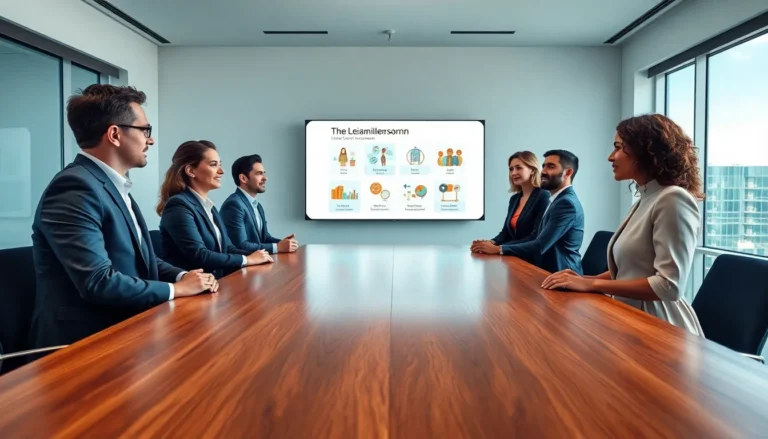In a world where technology and politics collide like two caffeinated squirrels in a nut factory, understanding the technopolitical landscape has never been more crucial. As innovations race ahead at breakneck speed, the implications for governance, society, and even your morning coffee routine are vast and often unpredictable.
Table of Contents
ToggleUnderstanding Technopolitical Forecast
Technopolitical forecasts examine the convergence of technology and politics. These assessments predict how technological advancements influence governance, societal norms, and daily life.
Definition of Technopolitical Forecast
Technopolitical forecast refers to the analytical process that anticipates future developments at the intersection of technology and political systems. It utilizes data analysis, historical patterns, and current trends to gauge how innovations affect policy-making, public opinion, and international relations. This process emphasizes the complexities inherent in technological shifts, providing insights into probable scenarios.
Importance in Contemporary Analysis
Understanding technopolitical forecasts holds significant value in today’s rapidly evolving landscape. Decision-makers rely on these forecasts to navigate challenges linked to technology, such as cybersecurity threats or digital governance reforms. By recognizing potential implications, businesses and governments enhance their strategic planning. Anticipating technological impacts fosters informed policymaking, ensuring societal stability amidst change. Furthermore, insights derived from these forecasts can guide innovation, aligning it with public needs and ethical standards.
Key Factors Influencing Technopolitical Forecast

Understanding the key factors influencing technopolitical forecasts is crucial for anticipating future trends. Several dynamics shape these predictions.
Technological Advancements
Technological advancements play a vital role in shaping governance structures. Innovations like artificial intelligence enhance data analysis capabilities, allowing for informed decision-making. The rise of automation impacts labor markets and economic landscapes, creating both opportunities and challenges. Cybersecurity technologies are increasingly critical as digital threats escalate, requiring robust defenses. Blockchain technology offers transparency and security, influencing trust in institutions. Innovations such as 5G connectivity facilitate faster communication and access to information, further altering the political landscape.
Political Landscape Changes
Changes in the political landscape significantly affect technopolitical forecasts. Elections can shift power dynamics, influencing policies related to technology and innovation. Legislative changes often reflect societal attitudes toward technology, impacting regulations around data privacy and surveillance. Global geopolitics shape alliances and rivalries, driving technological cooperation or competition. The emergence of populist movements often leads to a reassessment of existing technological policies. Local governance increasingly incorporates technology to engage citizens, impacting decision-making processes.
Socioeconomic Influences
Socioeconomic factors heavily influence technopolitical forecasts. Economic disparities can determine access to technology and drive innovation in underserved areas. Education levels impact the workforce’s skillsets, shaping how societies adopt and adapt to new technologies. Public sentiment regarding technology’s role can drive policy changes and influence business strategies. Economic downturns often spur government initiatives aimed at technological investment to revitalize growth. The increasing demand for sustainable solutions reflects broader societal values, pushing technopolitical agendas toward eco-friendly innovations.
Methodologies in Technopolitical Forecasting
Understanding methodologies in technopolitical forecasting involves both quantitative and qualitative approaches. Each method plays a vital role in providing insights into the complex interplay between technology and politics.
Quantitative Approaches
Quantitative approaches mainly rely on numerical data and statistical methods. These techniques utilize large datasets to identify patterns and trends in technological developments and political responses. Analysts often employ predictive modeling and simulations to forecast potential future scenarios. Surveys and polls also gather public opinion regarding technology adoption and its implications. By analyzing this data, they can quantify risks and opportunities that technological innovations present to governance and society.
Qualitative Approaches
Qualitative approaches emphasize in-depth exploration of socio-political contexts and human experiences. Interviews and focus groups gather detailed information about how individuals and communities perceive technology’s impact on their lives. Case studies offer insights into specific instances of technological integration within political frameworks. Moreover, document analysis examines policy papers, regulations, and historical records. These methods unveil rich narratives that help contextualize quantitative findings, enhancing overall understanding of technopolitical dynamics.
Case Studies of Technopolitical Forecasting
Examining specific case studies highlights the practical applications and implications of technopolitical forecasting. These examples illustrate how technology influences politics and vice versa.
Historical Examples
Historical instances of technopolitical forecasting reveal significant insights. The early 2000s’ rise of the internet led to changes in governance models. Governments adapted regulatory frameworks, responding to the rapid expansion of online platforms. Predictions from that era suggested a shift towards decentralized information dissemination. The Arab Spring is another pivotal example, showcasing how social media influenced political mobilization. Forecasts indicated growing civic engagement through digital tools, facilitating protests against established regimes. These cases reinforce how technology has historically shaped political landscapes.
Modern Implications
Modern technopolitical forecasts continue to inform decision-making processes. The advent of artificial intelligence is transforming governance, enhancing data analytics capabilities for policymakers. Predictions show that AI will play a crucial role in shaping regulatory frameworks in areas like privacy and ethics. Current geopolitical tensions also provide a rich context for forecasting. Observers note that technological competition drives nations to innovate rapidly, influencing global power dynamics. These implications underscore the necessity for continuous monitoring and analysis, enabling businesses and governments to adapt strategies effectively in a rapidly evolving environment.
Challenges in Technopolitical Forecasting
Technopolitical forecasting faces significant hurdles that complicate accurate predictions. Data accuracy and reliability often serve as primary concerns in this field.
Data Accuracy and Reliability
Data sources can vary in credibility, affecting the quality of forecasts. Diverse datasets lead to inconsistent findings, especially when drawing from historical patterns. Utilizing outdated or biased information skews predictions, resulting in misguided conclusions. For instance, emerging technologies like artificial intelligence require updated metrics to ensure reliable analysis. Lost context in historical data can further distort interpretations, emphasizing the need for rigorous verification processes.
Predictive Limitations
Predictive limitations pose another challenge in technopolitical forecasting. Rapid technological advancements create uncertainty in long-term predictions. Unforeseen events, such as political upheaval or technological breakthroughs, can alter forecasts dramatically. Modeling methods may not account for sudden shifts in public sentiment or policy changes, diminishing their effectiveness. The complexity of socio-political dynamics also limits the ability to predict outcomes accurately. Embracing adaptable methodologies can enhance forecasting accuracy, allowing for real-time adjustments in response to emerging trends.
Navigating the technopolitical landscape requires a keen understanding of the intricate relationship between technology and governance. As innovations continue to evolve at an unprecedented pace, the ability to anticipate their implications becomes crucial for both policymakers and businesses. Technopolitical forecasts serve as essential tools in this endeavor, offering insights that help shape strategic decisions and foster responsible innovation.
By recognizing the multifaceted influences on technology and politics, stakeholders can better prepare for the challenges and opportunities that lie ahead. Embracing adaptable methodologies will enhance forecasting accuracy, ultimately guiding societies toward sustainable solutions and ensuring stability in an ever-changing world.






